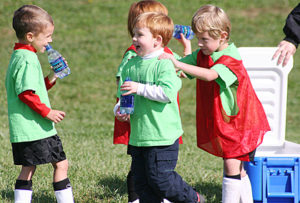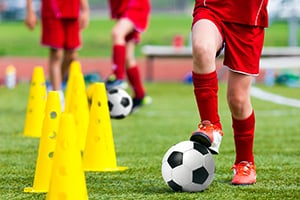From baseball to swimming to golf, Maryland’s list of youth sports goes on and on. As parents it is important to instill in children how to be as safe as possible when playing sports—and to make sure that the coaches are equally prepared. As we start to hit our peak high temperatures in Maryland, now is the time to think about the ways kids can stay safe and free of injury while playing sports.
Safety First
As a parent, it is important to know if there is emergency equipment and trained personnel on the sidelines while your children play sports. Coaches or support staff should all be trained in first aid and CPR at any sporting event. An automated external defibrillator (AED) is a lifesaving tool that anyone can use, and should be easily accessible at any event. An AED, locked away in the school or facility, is not useful during a Saturday game. If a child goes into cardiac arrest, it is often from abnormal heart rhythm, and AED can be used for a cardioversion to get the heart rhythm back into pace. If children are in/near the water, rescue equipment should be visible, and trained personnel should be at the sporting event.
Hydrate! Hydrate! Hydrate!
While children are out enjoying a good game, it is important that they are also staying hydrated. Dehydration can sneak up, especially in the middle of summer, if a young athlete is not careful. Parents, coaches, and athletes should know the signs of early dehydration and how to prevent it. By knowing this, they are able to prevent the worsening of dehydration, leading to heat exhaustion and heatstroke.
Symptoms of dehydration are:
- Unusually sleepy or drowsy
- Dry mouth
- Dry of sticky tongue
- High fever
In sports, the best defense is a good offense, so prevention is the best way to combat dehydration. Children should have water accessible to them at any sporting practice, game, or even at fun spur-of-the-moment afternoon activities with friends. Children should start hydrating about 30 minutes before play/game time and about every 15-20 min during the activity. A child waiting until they are “thirsty” has waited too long and dehydration has already begun.

Your child’s weight will determine the amount they should drink. American Academy of Pediatrics (AAP) recommends 5 oz. for an 88-pound child every 20 minutes and 9 oz. for a 132-pound adolescent every 20 minutes. Encourage children to drink regularly. A quick way to check if your child is drinking enough is to have them look at the color of their urine. Urine in a person who is healthy and well hydrated should be clear and look like lemonade. If your child is struggling to drink water, add fruit to their water for some flavor.
Sports Gear & Clothing
For sports requiring specific safety equipment, make sure the equipment is in good shape and fits appropriately. A helmet of an incorrect size will not safely protect during an impact and could result in a traumatic brain injury. Sports gear that is old or damaged will fail to prevent injury.
Kids are always growing. Before each sports season, check all gear and make sure it is in good shape, the correct size for the child and replace any damaged or too small gear with new, appropriate gear. Clothing is equally important, especially in the hot summer months, or cold winter months. Clothing material should be breathable and allow for wicking away of moisture from the body.
Lastly, it is important that children warm up before play and allow for adequate rest time in between games/events to prevent sports injuries. A day of rest is equally important as a day of training to prepare for the next event.
Reference
Safe Kids Worldwide (2021). Sports safety tips. https://www.safekids.org/tip/sports-safety-tips
Submitted by: Kelly Llewellyn, Injury Prevention Specialist at Meritus Health and Safe Kids Washington County Co-Coordinator


